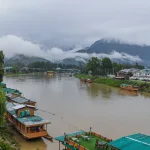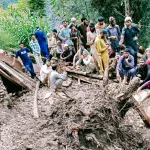It begins without warning. The skies darken not with majesty, but with menace. The air turns heavy, the wind stills, and in an instant, the clouds unleash a fury so fierce it stuns both earth and imagination. In the Himalayan belt—especially across Himachal Pradesh’s fragile slopes—the violence of nature has found its most terrifying expression in the form of cloudbursts and flash floods. No longer occasional anomalies, they now arrive in unsettling succession.
Just days ago, in an event that has shaken even hardened hill dwellers, seventeen cloudbursts were reported within a span of days in Mandi and Shimla. Villages were washed away, lives lost, bridges crumbled, roads vanished, and the familiar geography of the land was rewritten by an angry sky and furious waters.
These weren’t gentle mountain rains. These were sudden, crushing torrents—unpredictable, unrelenting, and unrepentant. Water came not as nourishment, but as a wall of death, sweeping everything in its path—homes, livestock, memories, entire histories. Hillsides buckled under pressure, boulders rolled like marbles, and what once were roads became rivers.
In the interiors of Mandi district, terrified families clutched one another as their rooftops gave way to roaring debris-laden streams. In Shimla, known once for its colonial charm and cedar-lined slopes, the hills trembled as cloudbursts collapsed entire hillsides onto settlements. Emergency crews waded through muck and stone, often digging with bare hands to retrieve what was once a home, now reduced to unrecognizable wreckage.
Cloudbursts—defined by meteorologists as extremely intense rainfall in a very short span over a small area—have become emblematic of the Himalayan region’s deepening ecological crisis. These events are marked not by rain but by water’s rage, falling faster than the land can absorb, channel, or resist. The deluge is so intense that it seems to collapse time itself—within an hour, decades of settlement and infrastructure can vanish.
The recent events in Mandi and Shimla make it painfully clear that this isn’t a one-off tragedy but a pattern that’s tightening its grip each monsoon. The sheer number of cloudbursts in such a short time speaks not only of meteorological extremity, but of a larger imbalance—between nature and man, between mountain and machine, between development and wisdom. These were not just natural calamities. They were brutal feedbacks from an ecosystem pushed to the edge.
One might ask—why now? Why has the frequency of these events intensified in recent years, and why are they so devastating? Climate change is at the heart of this storm. The Himalayas are warming faster than the global average.
Rising temperatures mean more moisture in the air, and when this moisture-laden air rises rapidly along mountain slopes and cools, it condenses violently—resulting in cloudbursts. Add to this the melting of glaciers, which overburdens rivers, weakens mountain faces, and triggers landslides, and we are left with a volatile landscape ripe for disaster.
But nature alone cannot be blamed. In truth, we have prepared the perfect stage for such calamities through reckless human intervention. Deforestation in the name of development has stripped the hills of their natural anchors. Trees, which once held the soil and absorbed excess rain, are being felled at alarming rates.
Urbanisation has turned riverbanks into settlements and slopes into colonies. Mountains are drilled for hydel projects, carved for roads, and blasted for tunnels—each blow weakening the spine of the very earth we walk upon.
In the aftermath of the Mandi–Shimla deluge, it was not just the rain that caused destruction—it was the roads that collapsed due to poor engineering, the homes built in riverbeds, the hilltops destabilised by constant mining and construction.
What should have been meandering brooks turned monstrous as they were blocked, redirected, or narrowed by thoughtless planning. The rivers, unable to find their paths, carved new ones—with terrifying consequences.
The response to such disasters also reveals systemic flaws. Early warning systems remain insufficient, especially in remote hill regions where cloudbursts strike hardest. By the time news of danger reaches residents, it is often already too late.
Rescue operations, though carried out with courage and commitment, are hindered by broken roads, landslides, and severed communication lines. Relief camps spring up, but they cannot compensate for lives lost, nor for the psychological scars etched into survivors’ minds.
In the wake of the recent devastation, locals recount stories that sound like apocalyptic fables. A father swept away while trying to save his daughter. An entire orchard—family-owned for generations—buried under layers of silt and stone. Temples reduced to rubble.
Elderly villagers staring at the vacant spaces where their homes once stood, silent with disbelief. A woman in Mandi recalled clinging to a rock for hours as floodwaters surged around her, her child tied to her back with nothing but a strip of cloth. Such stories do not leave communities unscathed. They leave behind a geography of grief.
The cost is not merely in lives and property. It is in memory, culture, and continuity. When a village vanishes, it takes with it not just shelters but songs, rituals, dialects, old temples, and ancestral roots. Flash floods and cloudbursts are erasing centuries of heritage—swiftly, savagely, and without pause.
So what now? Must we surrender to this cycle of mourning and rebuilding? Or can we change the way we live in these mountains?
The answer lies in humility and foresight. We must recognise that the Himalayas are not just a topography—they are a living, breathing entity with limits. Development must return to its senses. Construction in eco-sensitive zones must be curtailed.
Reforestation should not be symbolic but systematic and scientific. Town planning needs a seismic and hydrological consciousness. Small-scale, community-based water harvesting, traditional architectural wisdom, and decentralised disaster preparedness can go a long way in building resilience.
Cloudbursts and flash floods may never be entirely preventable. But the scale of their destruction certainly can be mitigated. By aligning our actions with ecological intelligence rather than economic greed, we can at least hope to reduce the number of lives lost and homes destroyed.
The recent catastrophe in Mandi and Shimla is not just a regional warning—it is a mirror held up to us all. If we fail to read it now, the mountains will write their rage in water again and again. And the ink, as always, will be blood and stone.
Let this not be just another news cycle. Let it be a turning point—where disaster teaches caution, where water demands reverence, and where we begin to listen before the next torrent speaks.
(Author is RK Columnist and can be reached at: [email protected])








